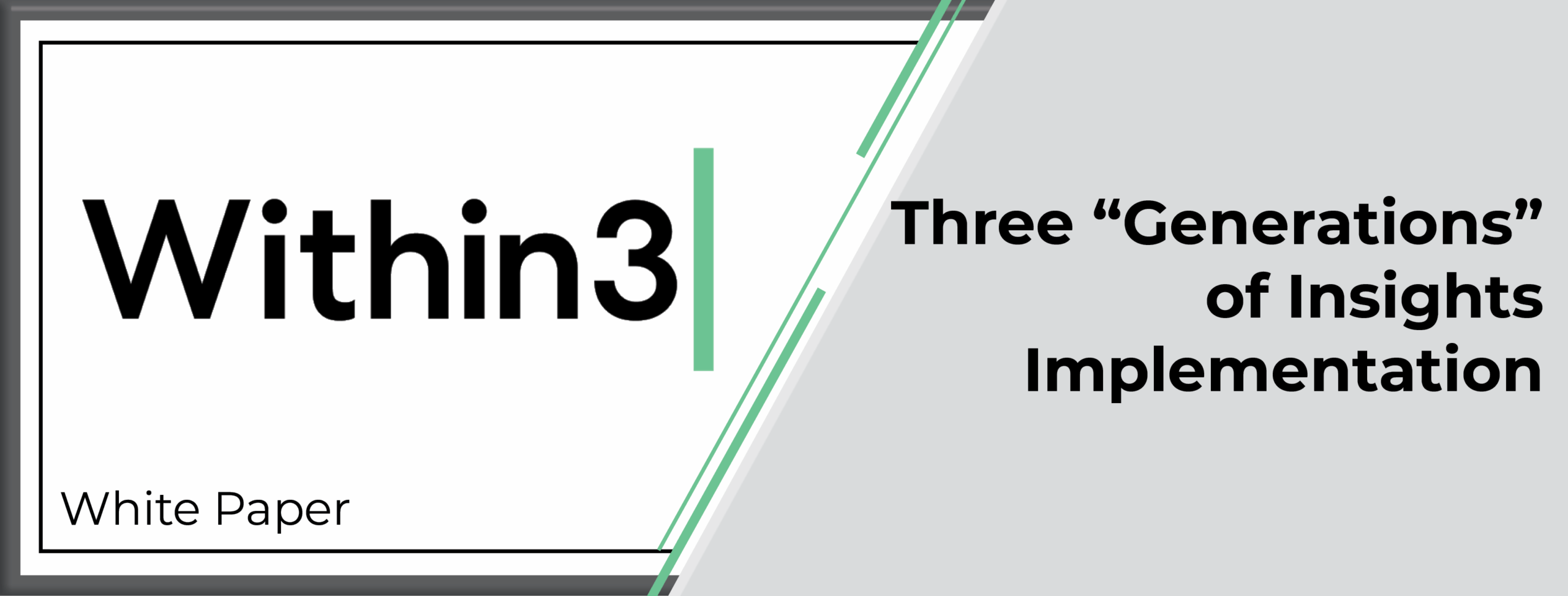The following authors contributed to this publication:
- Tamsin Naseem, Head of Global Medical Operations and Effectiveness, Jazz Pharmaceuticals
- Lourdes Barrera, Executive Director, Medical Affairs, Merck & Co., Inc.
- Amita Joshi, Global Director, Medical Affairs, Johnson & Johnson
- Gerald Miciak, Associate Director, Medical Affairs, Otsuka
- Andree Amelsberg, Senior VP, Medical Affairs Oncology, Eisai
- Leona Blustein, Senior Director, National MSL Leader, Idorsia Pharmaceuticals USA, Inc.
- John Sandstrom, VP, Head of Medical Affairs–Oncology, Sumitomo Pharma America
- Lance Hill, CEO, Within3
The views expressed in this paper are those of the authors and do not represent their organizations.
INTRODUCTION
This is the third White Paper in a series of collaborations between MAPS and Within3 that collects the expertise of Medical Affairs leaders to describe the process, promise, and perils of Insights Management. The first paper, titled “The Value and Strategic Implementation of Insights Management,” detailed the components and execution of a successful Insights Management program. The second paper “Identifying and Addressing Pain Points in the Insights Management Process,” offered advice for those not following the recommendations in the first paper. The current paper takes the next step, namely looking at how companies have implemented Insights Management in simple to mature ways, providing a vision for building the Insights Management process that best suits your organization.
To gain insights into insights, the authors conducted a series of polls and roundtables, the results of which are included in Appendix A, but which generally show an unsettled landscape that can be summarized as follows:
No industry-wide standards exist, perceived challenges abound and, while a few companies feel as if they are doing Insights well, most are still cobbling together makeshift systems to keep insights from grinding to a halt completely.
One thing on which everyone agrees is the critical importance of Insights to Medical Affairs and to the business as a whole, which can be summarized as follows:
If a business wants to change clinical behavior, they need to know the current clinical behavior and what is needed to change clinical behavior in line with new medicines. Insights generate this knowledge.
Now the question becomes how to bridge the “unsettled landscape” and the “critical importance?” The answer can be seen in the evolution of the insights process.
First-Generation Insights Management: The Spreadsheet Age
Evidence from South Africa’s Wonderwerk Cave shows that sometime around 1 million years ago, human ancestors rubbed sticks together to create fire. Similarly, in the late 1990s, early Homo technologus realized that learnings from the external healthcare community could be captured in a spreadsheet and reported back to the company.
And there were Insights.
As Medical Affairs learned to better harness this new and powerful knowledge, processes emerged: Medical Science Liaisons (MSLs) would type meeting notes; interesting snippets from these notes would be placed into the aforementioned spreadsheet; a manager would read through these “Insights”; and those that seemed interesting would float to the top of the primordial ooze of Insights data to become part of a PowerPoint that would be presented to company leaders.
Interestingly, our polling (see Appendix) showed that most organizations feel capable of generating Insights data from sources such as MSLs, Medical Information, and even social listening. Instead, analyzing data is now widely identified as the most labor-intensive part of the Insights Management process. And the analysis challenge grows along with the company.
Take an early-stage biotechnology company. With a small volume of data, it may work perfectly well to capture Insights via spreadsheet, analyze them via opinion, and communicate them via PowerPoint. But as volume or complexity increases, this system is quickly overwhelmed. As a larger company, or our hypothetical biotech company, grows, they risk becoming the proverbial frog in a pot of boiling water: They don’t notice their Insights Management process gradually becoming inadequate until they are parboiled. Early warning signs of an inadequate spreadsheet-age Insights Management process include uncountable hours spent harmonizing data from different sources – say, Insights data from Field Medical, Medical Information, Congresses, and Commercial. Or the recognition that Insights are siloed within the functions that originally generated the data. Or a Medical Director opening the Insights spreadsheet to find 1,743,567 rows of free-text inputs. Or the Insights team needing to hire a squadron of data entry specialists specifically to apply keywords and tags to these 1,743,567 rows of free-text inputs.
Even in the spreadsheet age, some of these challenges can be solved by a strategy-first approach to Insights Management. For example, Insights data may be grouped or “bucketed” into the categories defined by strategic listening priorities. (See the first paper in this series for detail.) And some statistical analyses are possible within spreadsheets, for example, to monitor the change of certain strategically important Insights over time.
This strategy-first approach also helps to ensure that analysis is meaningful. For example, reading through a spreadsheet of snippets from MSL engagements might identify topics that are interesting but lack strategic importance. As one roundtable participant said, “You know the doctor has a dog and know their birthday, but you don’t know what is meaningful to the organization or any actions that need to be taken.”
By taking a strategy-first approach, we not only create scaffolding on which to hang our raw data but also hint at how these data may be relevant to making actionable recommendations. One roundtable participant described delivering Insights without making actionable recommendations as, “Running 26 miles of a marathon and stopping 0.2 miles before the finish line.” But, eventually even strategy won’t be able to save you from the hot water of Insights overload. In that case, you will need Second-Generation Insights processes.




